![]()
|
George Jones (& Co) George
Jones & Sons Ltd
|
Location and period of operation:
|
George Jones & Co |
Stoke |
1861 |
1873 |
|
George
Jones & Sons Ltd |
Stoke |
1873 |
1957 |
Manufacturer of earthenware, majolica and china ware at Stoke, Stoke-on-Trent
|
|
Napoleon III Empereur |
Napoleon
III Empereur Fragment found (2024) during excavations in the town of Lincoln, Ontario, Canada. photo courtesy: Courtney Corbeil |
|
Following the 1851 "Great Exhibition of the Works of Industry of All Nations" held in the Crystal Palace in London, many world cities held international exhibitions to showcase state-of-the-art science and technology. George Jones won a medal at three of these exhibitions: 1862 London International Exhibition, 1867 Paris Exposition and the 1873 Vienna World's Fair. |
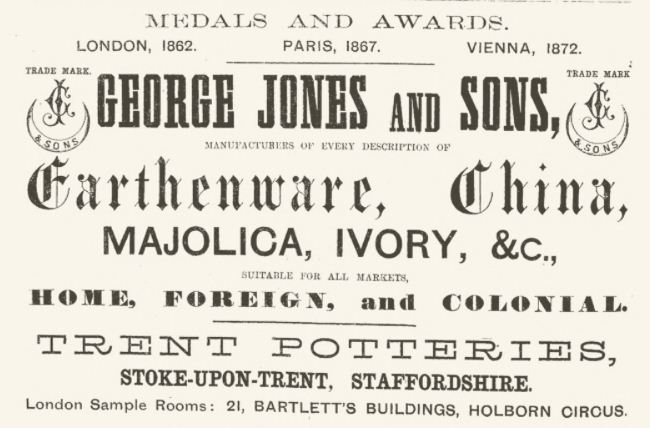
George Jones
and Sons
Manufacturers of every description of
Earthenware, China, majolica, Ivory, &c.,
Trent Potteries
Stoke-upon-Trent, Staffordshire
The Pottery Gazette, February 2nd 1880
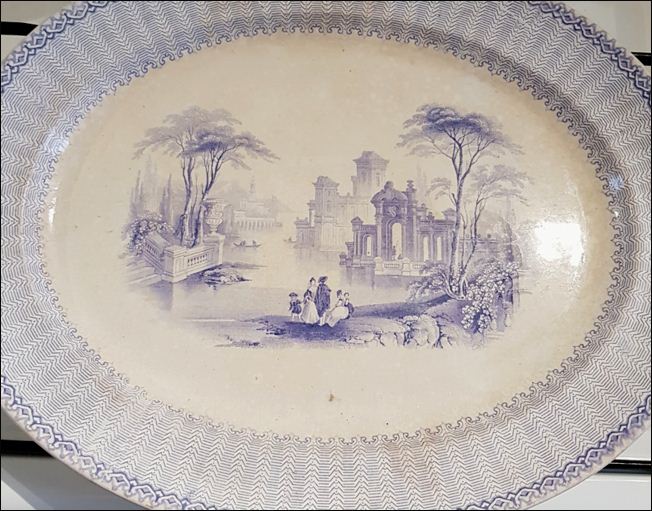 blue & white transferware platter |
|
1861-73
photos courtesy: MaryAnn Seymour, NSW Australia
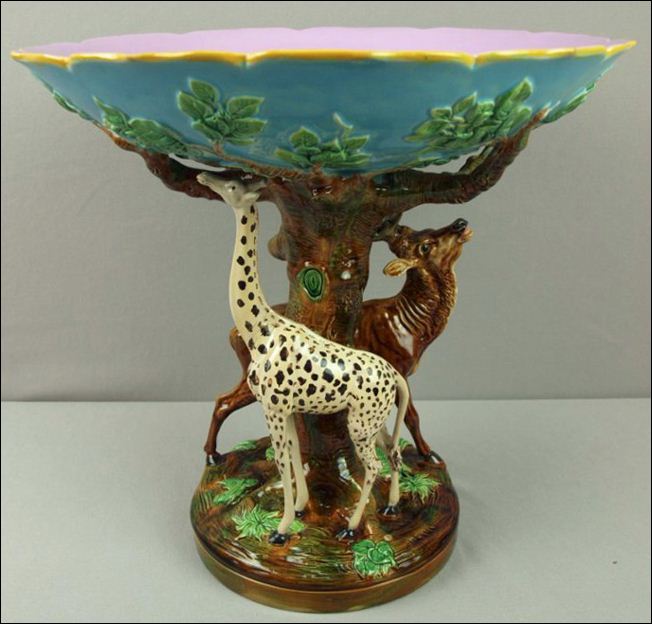
Majolica compote with giraffe
and antelope
|
Geroge Jones was a prolific manufacturer of majolica. The business produced a wide range of ware of sufficient quality to rival Minton and Wedgwood. The Majolica International Society provides more information on George Jones |
 Ironstone bowl The bottom is marked in black "Stone China George Jones Stoke - upon - Trent" with a lion and unicorn on either side of a crest. There is also an impressed "Ironstone George Jones Stoke on Trent" in an Oval. |
 5" high urn by George Jones & Sons and sold by Tiffany & Co. New York. |
|
|
|
 red transferware ironstone plate in the classic ABBEY pattern |
|
|
|
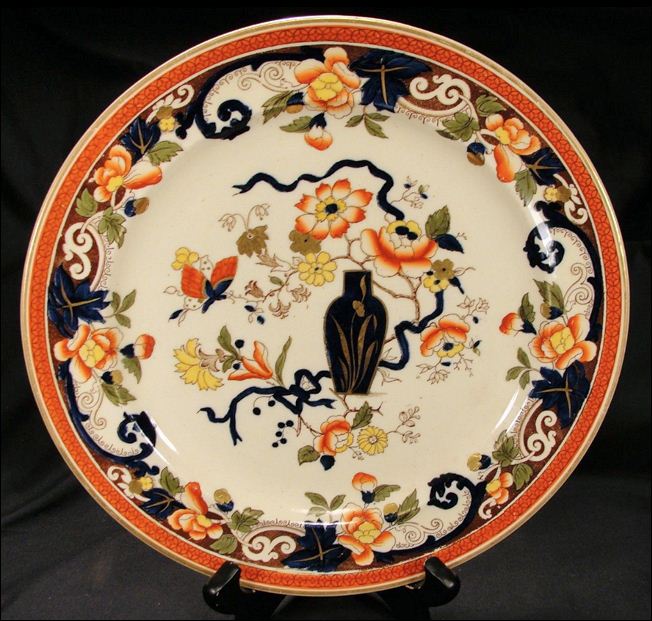 plate in the Sutherland Japan pattern printed outline with hand colouring, cobalt blue clobbering and gilt accents |
printed mark
impressed
crescent mark c.1873 - when George Jones & Co became George Jones & Sons Ltd |
Pyrethrum pattern
|
This popular pattern was registered on on the 25th January 1884 to George Jones & Sons. Registration number: 826 Pyrethrum
was a genus of a number of Old World plants now classified in either
Chrysanthemum or Tanacetum. This particular pattern is noteworthy for including flying bees hovering above the flowers and is often referred to as Bees & Daisies. It was designed by Horace Overton Jones (1856-1928) who was one of George Jones’s sons. He had studied at the National Art Training School (now called the Royal College of Art) and in 1877 was awarded two prizes in a national competition in the category ‘painting flowers from nature’. |
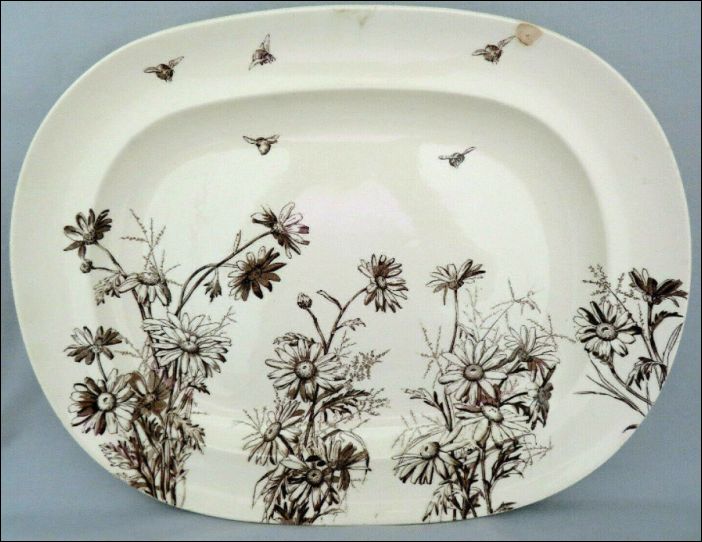 serving platter - black monochrome transfer platter in the Pyrethrum pattern Pyrethrum flowers with bees |
printed registration number |
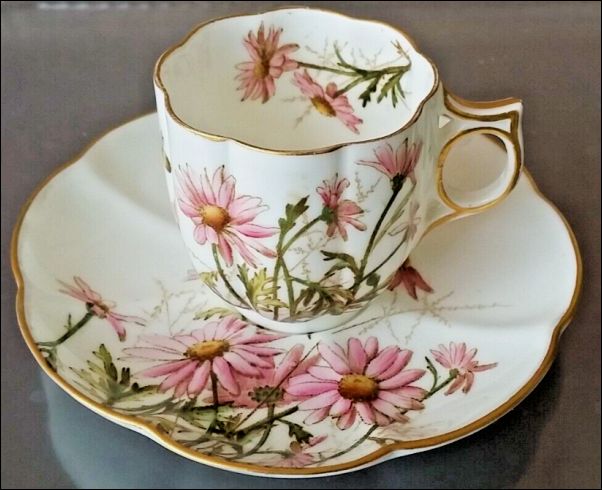 cup & saucer in the Pyrethrum pattern hand coloured with gilt edging |
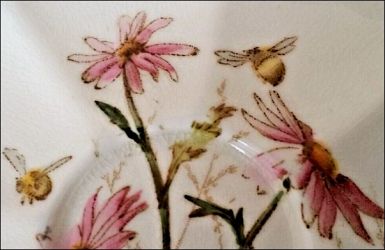
printed registration number |
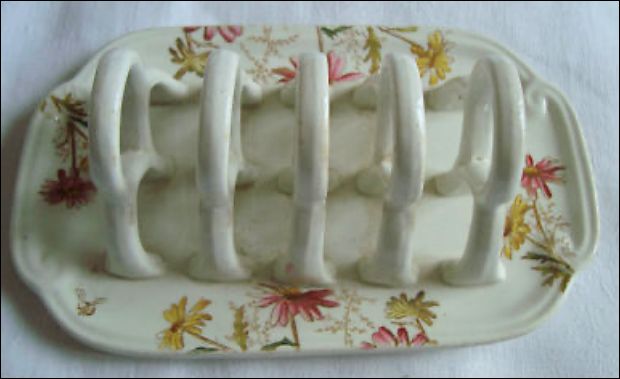 toast rack in the Pyrethrum pattern |
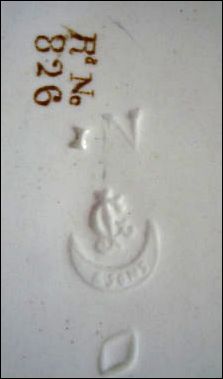 Rd No 826 printed registration number
G J impressed crescent mark |
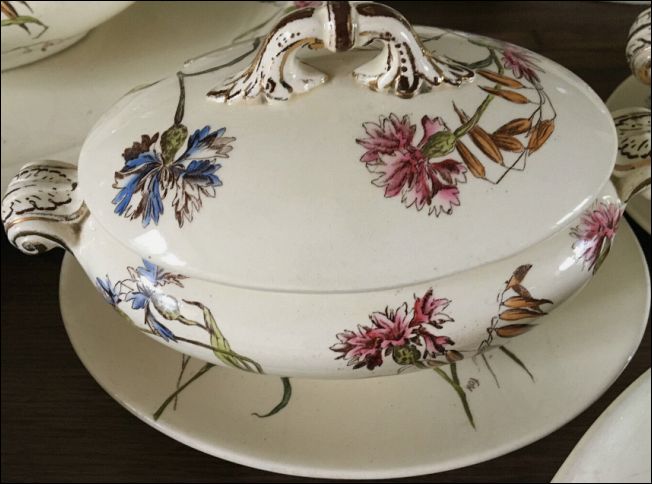
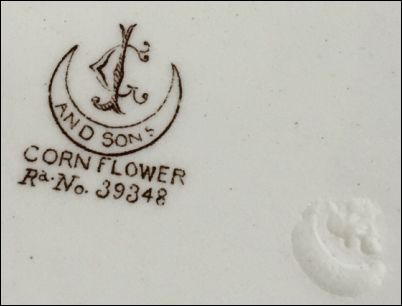
Cornflower
pattern
the registration number 39348
shows that this pattern was registered on the 8th December 1885
this pattern was designed by Horace Overton Jones
the Abbey pattern
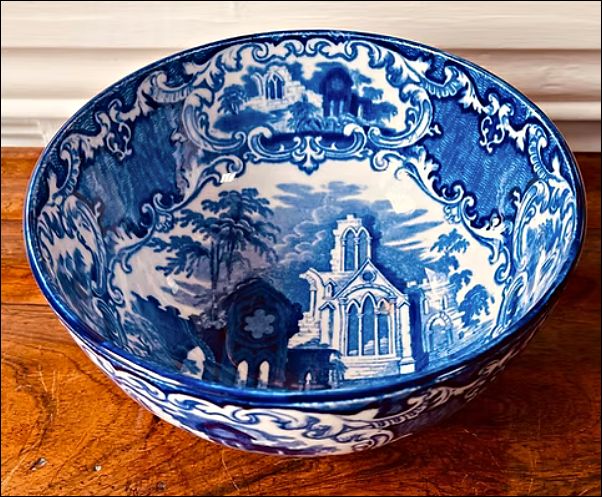
bowl by George Jones & Sons
in the Abbey pattern
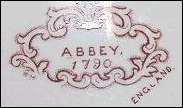 Abbey 1790 England |
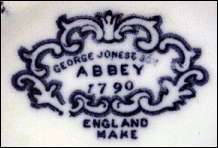 George Jones & Sons Abbey 1790 England Make |
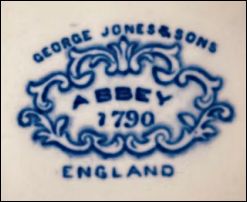 George Jones & Sons Abbey 1790 England |
|
When the business was established in 1861 George Jones purchased a number of 'named engravings' from William Adams. This included the Abbey Wreath pattern which Adams had first produced in the 1840s. This pattern, which features the ruins of an abbey, was introduced by George Jones & Sons around 1901. It was simply called 'Abbey'. All
the marks for the Abbey pattern produced by George Jones include the
date 1790, the relevance of this date is uncertain - it probably acts as a form of historical branding or association, aiming to evoke a sense of tradition and heritage, rather than indicating
a significant event.
|
Ware supplied to the British Government

photos courtesy: John Prasanth
Jacob |
G
VI R
|
|
The mark shown indicates that the ware was produced for and supplied to the British Government; it was ultimately property of the Crown/Government, hence the GR-VI Cypher. This mark is there to distinguish the piece from being normal ‘utilitarian’ ware for public sale during the period surrounding the Second World War. George Jones & Sons (and others) were given government contracts throughout the late 1930s and into the 1940s (WWII) and produced canteen ware for the armed services and government establishments. The year of manufacturer is generally included. |
Marks and initials used on ware for identification:
| Early George Jones majolica
was marked with the impressed superimposed letters GJ contained within a
circle. In 1873, a crescent inscribed with "& SONS" was
added beneath the initials.
Many pieces also have a small unglazed area or "thumbprint" which has a pattern number written in black ink. Often ware also bear a British registry mark. |
George Jones
c.1861-73
G J
c.1872 - 1891
G J & Co
c.1872 - 1891
G J & SONS
"& Sons"
was added from 1873
CRESCENT
the trade name Cresent
was registered in 1873
although it may have been used before that date
STONE CHINA
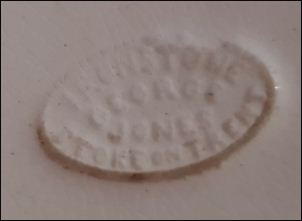
Ironstone
Gerorge Jones
Stoke-on-Trent
c.1861 - 1873
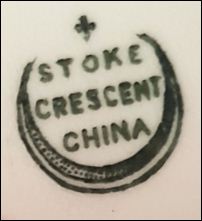 Stoke Crescent China c.1872 - 1891 this mark appeared on a plate with the registration number 826 - which means the pattern was registered in 1884 |
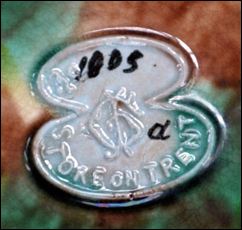 GJ Stoke-on-Trent c.1861 - 1873 moulded mark from a majolica dish Rarely seen is a raised two lobed cartouche with STOKE ON TRENT below the initials and the pattern number in ink above. |
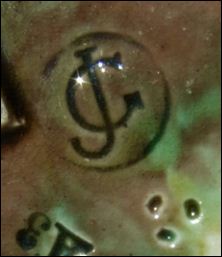 JG c.1861 - 1873 as either an impressed or moulded mark The monogram only (i.e. GJ without the crescent) used c.1861-72 when the company was "George Jones" (without the "& SONS") |
c.1861 - 1873 Some marks incorporate "Stoke-upon-Trent" and / or "Stone China" click for more on the use of the Royal Arms
|
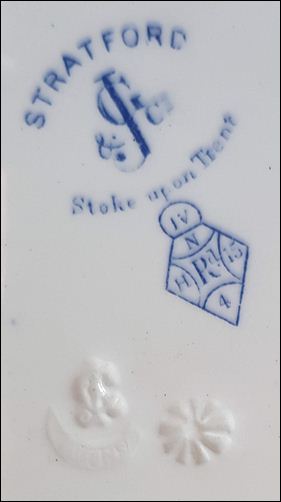 Stratford is the pattern name The registration diamond gives a date for the registration of the pattern as 5th April 1864 |
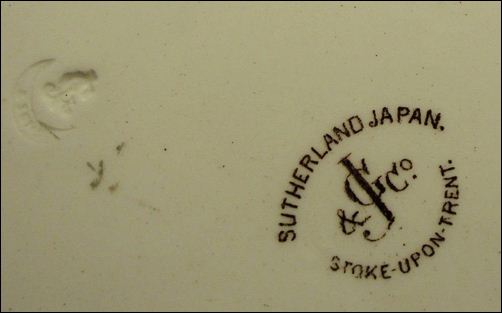 Sutherland Japan is the pattern name |
G J & Co
Stoke-upon-Trent
these printed marks also have the
impressed crescent mark with '& Sons' this would indicate that
the ware was produced around 1873 when it was changing from '& Co' to '&
Sons'
|
c.1873 - 1907 an early George Jones & Sons mark (post 1873) |
without 'ENGLAND' - |
with 'ENGLAND' - |
|
| Note the use of "ENGLAND" which generally indicates a date post 1891 |
BRIAR is the pattern name.
Note the introduction of the crescent shape but without the word "CRESCENT" Printed mark on base and diamond registration mark for 16th September 1881 therefore this mark was after that date. |
diamond registration mark for 1883 therefore this mark was after that date |
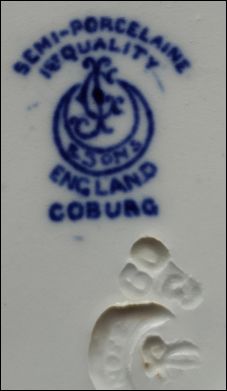
Semi-porcelaine
1st Quality
G J & Sons
England
the impressed "3 09"
is the month/year of manufacturer
- in this instance March 1909
COBURG is the pattern name
|
Mark found on an eight sided plate - plate was made for & sold by Marshall Field & Co. Chicago. Likely to have been produced by George Jones & Sons |
|
c.1874-1924 Example of impressed mark |
|
|
With the use of "MADE IN ENGLAND" |
post 1920 mark |
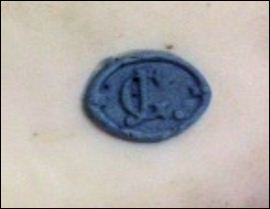
| NOT GEORGE JONES - this mark 'JG' on a raised blue pad
can be confused as 'GJ' - but it has no
connection wth George Jones,
it was used by Jean Gille of Paris, France from c.1840's to 1868
|
click the picture for more on the Crescent Works
questions/comments/contributions? email: Steve Birks